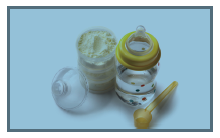In a double-blind, randomized trial, 230 infants with HLA-conferred susceptibility to type 1 diabetes and at least one family member with type 1 diabetes were assigned to receive either a casein hydrolysate formula or a conventional, cow’smilk- based formula (control) whenever breast milk was not available during the first 6 to 8 months of life. Autoantibodies to insulin, glutamic acid decarboxylase (GAD), the insulinomaassociated 2 molecule (IA-2), zinc transporter 8, and islet-cell antibodies were analyzed during a median observation period of 10 years. The unadjusted hazard ratio for having a positive test for one or more autoantibodies was 0.54 (95% CI 0.29-0.95) in the casein hydrolysate group compared with the control group; the adjusted HR was 0.51 (95% CI 0.28-0.91). The unadjusted hazard ratio for positivity for two or more autoantibodies was 0.52 (95% CI 0.21-1.17), and the adjusted hazard ratio was 0.47 (95% CI 0.19-1.07). In the per-protocol cohort the hazard ratio for incidence type 1 diabetes with casein hydrolysate was 0.40 (95% CI, 0.11 to 1.51), incidence rate 4% versus 8%. Use of hydrolyzed whey protein in preference to other formula types may reduce risk of type 1 diabetes. (N Engl J Med. 2010 Nov 11;363(20):1900-8.) PMID: 21067382.









